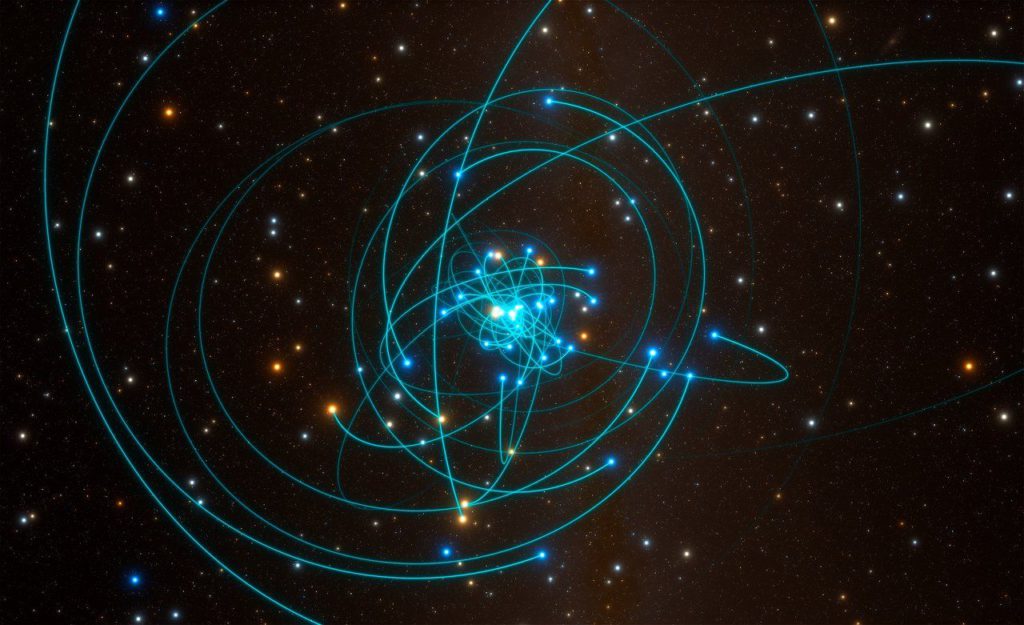Obscured by thick clouds of absorbing dust, the closest supermassive black hole to the Earth lies 26 000 light-years away at the centre of the Milky Way. This gravitational monster, which has a mass four million times that of the Sun, is surrounded by a small group of stars orbiting around it at high speed. This extreme environment — the strongest gravitational field in our galaxy — makes it the perfect place to explore gravitational physics, and particularly to test Einstein’s general theory of relativity.
New infrared observations from the exquisitely sensitive GRAVITY [1], SINFONI and NACO instruments on ESO’s Very Large Telescope (VLT) have now allowed astronomers to follow one of these stars, called S2, as it passed very close to the black hole during May 2018. At the closest point this star was at a distance of less than 20 billion kilometres from the black hole and moving at a speed in excess of 25 million kilometres per hour — almost three percent of the speed of light [2].
Looking closely at the star near Sagittarius A*
The team compared the position and velocity measurements from GRAVITY and SINFONI respectively, along with previous observations of S2 using other instruments, with the predictions of Newtonian gravity, general relativity and other theories of gravity. The new results are inconsistent with Newtonian predictions and in excellent agreement with the predictions of general relativity.
These extremely precise measurements were made by an international team led by Reinhard Genzel of the Max Planck Institute for Extraterrestrial Physics (MPE) in Garching, Germany, in conjunction with collaborators around the world, at the Paris Observatory–PSL, the Université Grenoble Alpes, CNRS, the Max Planck Institute for Astronomy, the University of Cologne, the Portuguese CENTRA – Centro de Astrofisica e Gravitação and ESO. The observations are the culmination of a 26-year series of ever-more-precise observations of the centre of the Milky Way using ESO instruments [3].
“This is the second time that we have observed the close passage of S2 around the black hole in our galactic centre. But this time, because of much improved instrumentation, we were able to observe the star with unprecedented resolution,” explains Genzel. “We have been preparing intensely for this event over several years, as we wanted to make the most of this unique opportunity to observe general relativistic effects.”
The new measurements clearly reveal an effect called gravitational redshift. Light from the star is stretched to longer wavelengths by the very strong gravitational field of the black hole. And the change in the wavelength of light from S2 agrees precisely with that predicted by Einstein’s theory of general relativity. This is the first time that this deviation from the predictions of the simpler Newtonian theory of gravity has been observed in the motion of a star around a supermassive black hole.

This simulation shows the orbits of stars very close to the supermassive black hole at the heart of the Milky Way. One of these stars, named S2, orbits every 16 years and is passing very close to the black hole in May 2018. This is a perfect laboratory to test gravitational physics and specifically Einstein’s general theory of relativity. [ESO]
A first ever observation in astronomy
The team used SINFONI to measure the velocity of S2 towards and away from Earth and the GRAVITY instrument in the VLT Interferometer (VLTI) to make extraordinarily precise measurements of the changing position of S2 in order to define the shape of its orbit. GRAVITY creates such sharp images that it can reveal the motion of the star from night to night as it passes close to the black hole — 26 000 light-years from Earth.
“Our first observations of S2 with GRAVITY, about two years ago, already showed that we would have the ideal black hole laboratory,” adds Frank Eisenhauer (MPE), Principal Investigator of GRAVITY and the SINFONI spectrograph. “During the close passage, we could even detect the faint glow around the black hole on most of the images, which allowed us to precisely follow the star on its orbit, ultimately leading to the detection of the gravitational redshift in the spectrum of S2.”
More than one hundred years after he published his paper setting out the equations of general relativity, Einstein has been proved right once more — in a much more extreme laboratory than he could have possibly imagined!
Françoise Delplancke, head of the System Engineering Department at ESO, explains the significance of the observations: “Here in the Solar System we can only test the laws of physics now and under certain circumstances. So it’s very important in astronomy to also check that those laws are still valid where the gravitational fields are very much stronger.”
Continuing observations are expected to reveal another relativistic effect very soon — a small rotation of the star’s orbit, known as Schwarzschild precession — as S2 moves away from the black hole.
Xavier Barcons, ESO’s Director General, concludes: “ESO has worked with Reinhard Genzel and his team and collaborators in the ESO Member States for over a quarter of a century. It was a huge challenge to develop the uniquely powerful instruments needed to make these very delicate measurements and to deploy them at the VLT in Paranal. The discovery announced today is the very exciting result of a remarkable partnership.”


